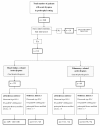Combination of lung ultrasound (a comet-tail sign) and N-terminal pro-brain natriuretic peptide in differentiating acute heart failure from chronic obstructive pulmonary disease and asthma as cause of acute dyspnea in prehospital emergency setting
- PMID: 21492424
- PMCID: PMC3219397
- DOI: 10.1186/cc10140
Combination of lung ultrasound (a comet-tail sign) and N-terminal pro-brain natriuretic peptide in differentiating acute heart failure from chronic obstructive pulmonary disease and asthma as cause of acute dyspnea in prehospital emergency setting
Erratum in
- Crit Care. 2011;15(6):450
Abstract
Introduction: We studied the diagnostic accuracy of bedside lung ultrasound (the presence of a comet-tail sign), N-terminal pro-brain natriuretic peptide (NT-proBNP) and clinical assessment (according to the modified Boston criteria) in differentiating heart failure (HF)-related acute dyspnea from pulmonary (chronic obstructive pulmonary disease (COPD)/asthma)-related acute dyspnea in the prehospital setting.
Methods: Our prospective study was performed at the Center for Emergency Medicine, Maribor, Slovenia, between July 2007 and April 2010. Two groups of patients were compared: a HF-related acute dyspnea group (n = 129) and a pulmonary (asthma/COPD)-related acute dyspnea group (n = 89). All patients underwent lung ultrasound examinations, along with basic laboratory testing, rapid NT-proBNP testing and chest X-rays.
Results: The ultrasound comet-tail sign has 100% sensitivity, 95% specificity, 100% negative predictive value (NPV) and 96% positive predictive value (PPV) for the diagnosis of HF. NT-proBNP (cutoff point 1,000 pg/mL) has 92% sensitivity, 89% specificity, 86% NPV and 90% PPV. The Boston modified criteria have 85% sensitivity, 86% specificity, 80% NPV and 90% PPV. In comparing the three methods, we found significant differences between ultrasound sign and (1) NT-proBNP (P < 0.05) and (2) Boston modified criteria (P < 0.05). The combination of ultrasound sign and NT-proBNP has 100% sensitivity, 100% specificity, 100% NPV and 100% PPV. With the use of ultrasound, we can exclude HF in patients with pulmonary-related dyspnea who have positive NT-proBNP (> 1,000 pg/mL) and a history of HF.
Conclusions: An ultrasound comet-tail sign alone or in combination with NT-proBNP has high diagnostic accuracy in differentiating acute HF-related from COPD/asthma-related causes of acute dyspnea in the prehospital emergency setting.
Trial registration: ClinicalTrials.gov NCT01235182.
Figures
Comment in
-
Using lung ultrasound to differentiate patients in acute dyspnea in the prehospital emergency setting.Crit Care. 2011;15(3):161. doi: 10.1186/cc10226. Epub 2011 May 26. Crit Care. 2011. PMID: 21635703 Free PMC article.
References
-
- Klemen P, Golub M, Grmec S. Combination of quantitative capnometry, N-terminal pro-brain natriuretic peptide, and clinical assessment in differentiating acute heart filure from pulmonary disease as cause of acute dyspnea in prehospital emergency setting: study of diagnostic accuracy. Croat Med J. 2009;50:133–142. doi: 10.3325/cmj.2009.50.133. - DOI - PMC - PubMed
-
- Michota FA Jr, Amin A. Bridging the gap between evidence and practice in acute decompensated heart failure management. J Hosp Med. 2008;3(6 Suppl):S7–S15. - PubMed
Publication types
MeSH terms
Substances
Associated data
LinkOut - more resources
Full Text Sources
Medical
Research Materials
Miscellaneous


